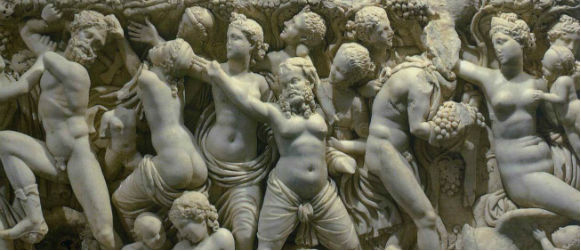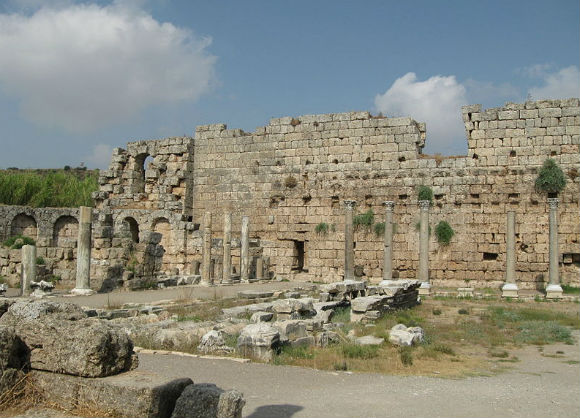Perga was an old city even in the first century. Its name (which is not Greek) indicates that its origin dates from pre-Greek times. Alexander the Great passed through it twice while the Pergaeans offered no resistance to him although it was a walled city with a citadel. In Roman times the main streets were over twenty-one meters wide. They were lined with Ionic colonnades and a water channel ran down their center in a series of small waterfalls as in Antalya today. Behind the colonnades stood the shops. Of the early buildings the stadium and the theater have survived the ravages of earthquakes and wars with the least damage. In fact this stadium which could seat about fourteen thousand people is one of the best preserved in Turkey.
The temple of the Pergaean Artemis according to a writer of the time was “a marvel of size, beauty, and workmanship.” Its location has yet to be established; it may have been where there are now ruins of a Byzantine church on a hill to the southeast of the city.
Perga is on a rise not far from the Cestrus River which was navigable In Paul’s time. It was not a seaport in terms of Its being directly on the Mediterranean even then, but rather it was more easily defended where it was: its distance from the open sea made it less vulnerable to piracy.
Two people stand out among the early residents of Perga. Apollonius was a third century B.C. astronomer and mathematician who believed that the movements of heavenly bodies in the universe were explainable by orbits within orbits: that the moon went around the earth as the earth went around the sun. He was much ahead of his time in his theories of astronomy, so much so that the ideas had to be rediscovered during the Renaissance. Plancia Magna was unusual for a second century A.D. woman: she held the highest city office during her life, that of demiurgus. She must have been well-to-do for a number of inscriptions record her gifts to the city.
Paul and Barnabas went through Perga on their way to and from Antioch on their first journey (Acts 13:13, 14:25). John Mark was with them at first but left them at Perga to return to Jerusalem. The reason for that must have been such that Paul doubted his commitment to the cause. Later when Paul and Barnabas were about to start on their second journey from Antioch they had a sharp dispute over his worthiness. Paul refused to have him go along, so John and Barnabas went to Cyprus while Paul chose Silas to accompany him.
Paul talks in II Corinthians 12:7 and in Galatians 4:13-14 of bodily illness that brought him to Galatia the first time. It may have been on that account that he did not stay long in Perga the first time. Whatever the illness was, it seems to have improved in time in the dry mountain air to the north.
The second theory of why they did not stay long in Perga is that their interview with Sergius Paulus, the proconsul of Cyprus, had made them want to hurry to the Roman colony in Antioch of Pisidia. This interpretation may lay too much stress on the lasting importance of that meeting with a cultured Roman who could have been more interested in the pursuits of the mind than the salvation, in Christian terms, of his soul. It is interesting, however, that this is” the point in Acts (13:9) that Luke begins to call Paul by his Roman name, not his Jewish “Saul”.
On their return they did stay in Perga long enough to preach and talk with people there. Nothing else is told about the city or their time there.
Perga,






These are the most complete Roman ruins I have seen anywhere in the world. The theatre is under repair but everything else can be seen – the market place,the baths, the stadium, the high street and the water system that divided the town. Tread the stones where Alexander The Great and St Paul walked.
You don't need a taxi or…
Great historical site with great atmosphere. Archaeologically largely unexplored. Explored "only" roman bath and areas around main street. Perfect fountain cross down city. Its pity that upper city isnt available for tourist.
Not crowded with tourists. Site of the recent finds in the region and it's easy to arrange a toure of Perge and other nearby attractions.
Wonderful Roman city. A must for every vist to Antylia
Excavations at this site by archaeologists commenced in 1946 and there has been considerable restoration, especially of the superb theatre, colonnaded street and northern nymphaeum. Be aware that some areas are closed on a regular basis for further work.
It was disheartening to talk to those involved with restoration to learn about looting with some repairs and replaced capitals stolen…
great place go with a guide or tag along with a group when there as there is not much info otherwise.
As mentioned by others, one can enjoy this site without the crowds found elsewhere, such as Ephesus. The baths, fourm and the "divded" main road gives one a sense of how prosperus this city was. All the beautiful artwork can be seen at the Anatolya Archeological Museum. Need to see both to truly appreciate.
Big place easy to walk around. Not full of tourists and in good conditions that will allow you to imagine how all these stones were in a time buildings and streets.
For Roman civilisation-phobes a must see place. Lots to view, in fact allow a morning or afternoon to wander around the theatre, stadium etc.
I know that Ephesus is the not-to-miss major attraction, and it should definitely be number one of all the things to see in Turkey. However, Perge is not to be missed! It is much more scaled down, has the most intricate detailed ruins that remain and is much less crowded. Perhaps because it is farther away than Istanbul than most…